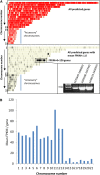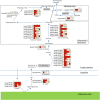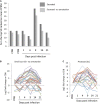Transcriptome and metabolite profiling of the infection cycle of Zymoseptoria tritici on wheat reveals a biphasic interaction with plant immunity involving differential pathogen chromosomal contributions and a variation on the hemibiotrophic lifestyle definition
- PMID: 25596183
- PMCID: PMC4348787
- DOI: 10.1104/pp.114.255927
Transcriptome and metabolite profiling of the infection cycle of Zymoseptoria tritici on wheat reveals a biphasic interaction with plant immunity involving differential pathogen chromosomal contributions and a variation on the hemibiotrophic lifestyle definition
Abstract
The hemibiotrophic fungus Zymoseptoria tritici causes Septoria tritici blotch disease of wheat (Triticum aestivum). Pathogen reproduction on wheat occurs without cell penetration, suggesting that dynamic and intimate intercellular communication occurs between fungus and plant throughout the disease cycle. We used deep RNA sequencing and metabolomics to investigate the physiology of plant and pathogen throughout an asexual reproductive cycle of Z. tritici on wheat leaves. Over 3,000 pathogen genes, more than 7,000 wheat genes, and more than 300 metabolites were differentially regulated. Intriguingly, individual fungal chromosomes contributed unequally to the overall gene expression changes. Early transcriptional down-regulation of putative host defense genes was detected in inoculated leaves. There was little evidence for fungal nutrient acquisition from the plant throughout symptomless colonization by Z. tritici, which may instead be utilizing lipid and fatty acid stores for growth. However, the fungus then subsequently manipulated specific plant carbohydrates, including fructan metabolites, during the switch to necrotrophic growth and reproduction. This switch coincided with increased expression of jasmonic acid biosynthesis genes and large-scale activation of other plant defense responses. Fungal genes encoding putative secondary metabolite clusters and secreted effector proteins were identified with distinct infection phase-specific expression patterns, although functional analysis suggested that many have overlapping/redundant functions in virulence. The pathogenic lifestyle of Z. tritici on wheat revealed through this study, involving initial defense suppression by a slow-growing extracellular and nutritionally limited pathogen followed by defense (hyper) activation during reproduction, reveals a subtle modification of the conceptual definition of hemibiotrophic plant infection.
© 2015 American Society of Plant Biologists. All Rights Reserved.
Figures












Similar articles
-
Comparative transcriptomic analyses of Zymoseptoria tritici strains show complex lifestyle transitions and intraspecific variability in transcription profiles.Mol Plant Pathol. 2016 Aug;17(6):845-59. doi: 10.1111/mpp.12333. Epub 2016 Feb 8. Mol Plant Pathol. 2016. PMID: 26610174 Free PMC article.
-
Transcriptional reprogramming of wheat and the hemibiotrophic pathogen Septoria tritici during two phases of the compatible interaction.PLoS One. 2013 Nov 26;8(11):e81606. doi: 10.1371/journal.pone.0081606. eCollection 2013. PLoS One. 2013. PMID: 24303057 Free PMC article.
-
Analysis of two in planta expressed LysM effector homologs from the fungus Mycosphaerella graminicola reveals novel functional properties and varying contributions to virulence on wheat.Plant Physiol. 2011 Jun;156(2):756-69. doi: 10.1104/pp.111.176347. Epub 2011 Apr 5. Plant Physiol. 2011. PMID: 21467214 Free PMC article.
-
Previous bottlenecks and future solutions to dissecting the Zymoseptoria tritici-wheat host-pathogen interaction.Fungal Genet Biol. 2015 Jun;79:24-8. doi: 10.1016/j.fgb.2015.04.005. Fungal Genet Biol. 2015. PMID: 26092786 Free PMC article. Review.
-
A Review of the Interactions between Wheat and Wheat Pathogens: Zymoseptoria tritici, Fusarium spp. and Parastagonospora nodorum.Int J Mol Sci. 2018 Apr 10;19(4):1138. doi: 10.3390/ijms19041138. Int J Mol Sci. 2018. PMID: 29642627 Free PMC article. Review.
Cited by
-
Genome-wide analysis of the polyamine oxidase gene family in wheat (Triticum aestivum L.) reveals involvement in temperature stress response.PLoS One. 2020 Aug 31;15(8):e0236226. doi: 10.1371/journal.pone.0236226. eCollection 2020. PLoS One. 2020. PMID: 32866160 Free PMC article.
-
Plant PhysioSpace: a robust tool to compare stress response across plant species.Plant Physiol. 2021 Nov 3;187(3):1795-1811. doi: 10.1093/plphys/kiab325. Plant Physiol. 2021. PMID: 34734276 Free PMC article.
-
An integrated RNAseq-1H NMR metabolomics approach to understand soybean primary metabolism regulation in response to Rhizoctonia foliar blight disease.BMC Plant Biol. 2017 Apr 27;17(1):84. doi: 10.1186/s12870-017-1020-8. BMC Plant Biol. 2017. PMID: 28449662 Free PMC article.
-
Comparative transcriptomic analyses of Zymoseptoria tritici strains show complex lifestyle transitions and intraspecific variability in transcription profiles.Mol Plant Pathol. 2016 Aug;17(6):845-59. doi: 10.1111/mpp.12333. Epub 2016 Feb 8. Mol Plant Pathol. 2016. PMID: 26610174 Free PMC article.
-
The complete genome sequence of the phytopathogenic fungus Sclerotinia sclerotiorum reveals insights into the genome architecture of broad host range pathogens.Genome Biol Evol. 2017 Mar;9(3):593-618. doi: 10.1093/gbe/evx030. Epub 2017 Feb 15. Genome Biol Evol. 2017. PMID: 28204478 Free PMC article.
References
-
- Apel K, Hirt H (2004) Reactive oxygen species: metabolism, oxidative stress, and signal transduction. Annu Rev Plant Biol 55: 373–399 - PubMed
-
- Bari R, Jones JDG (2009) Role of plant hormones in plant defence responses. Plant Mol Biol 69: 473–488 - PubMed
-
- Benjamini Y, Hochberg Y (1995) Controlling the false discovery rate: a practical and powerful approach to multiple testing. J R Stat Soc B 57: 289–300
Publication types
MeSH terms
Substances
Grants and funding
LinkOut - more resources
Full Text Sources
Other Literature Sources
Molecular Biology Databases

